| |
Pure Software code |
|
| |
Lebanon  | |
 |
|
|
 |
|
Home
: The 11
Monolithic Rock Hewn Churches, LALIBELA |
|
|
| | |

| |
|
|
|
Lalibela, the 11 Monolithic Rock Hewn
Churches/Bietes |
|
|
|
|
the Plan: |
|
1 |
LALIBELA
is Center of Pilgrimage |
|
|
| |
|
Lalibela is a town in Semien
Wollo Zone in Amhara Region, northern Ethiopia
(Ethiopia Country) famous for monolithic
rock-cut churches.
Lalibela is
one of Ethiopia's holiest cities, second only to
Aksum, and a Center of Pilgrimage. Unlike Aksum,
the population of Lalibela is almost completely
Ethiopian Orthodox
Christian. Ethiopia is one of the
earliest nations to adopt Christianity in the
first half of the fourth century, and its
historical roots date to the time of the
Apostles.
The
layout and names of the major buildings in
Lalibela are widely accepted, especially by
local clergy, to be a symbolic representation of
Jerusalem.This has led some experts to date the
current church forms to the years following the
capture of Jerusalem in 1187 by Muslim leader,
Saladin.
Lalibela
is located in the Semien Wollo Zone of the
Amhara Region of Ethiopia Country, at roughly
2,500 meters above sea level.
The Rock-Hewn
Churches were declared a UNESCO World Heritage
Site in
1978 | |
| |
 |
|
Ethiopia Location
Map |
|
|
| |
|
| New Jerualem, Roha,
Lalibela
Lalibella was the
brother of the ruling king of those times. When he
was born he was completely surrounded by swarm of bees.
His mother took this as a sign for his reign in future.
His brother, Harbay, never liked his mother to be
thinking that high of his brother. Somewhere in the
mind, he was also afraid of losing the kingdom to his
younger brother.
He tried to poison Lalibela, many
times, but failed. When Lalibela was poisoned by
his brother he slept for almost 3 days. It is said that
in those 3 days he was carried to heaven where he was
given instruction for building the rock town. Meanwhile,
his brother also had a vision where Lord Jesus paid a
visit to him and said that he should abdicate the throne
and hand it over to his brother.
Very after this
vision, his brother abdicated the throne. When Lalibela
became the king, he started the construction of the Rock
Hewn Churches. Before this place was known by the name
of Roha, but after these churches were built, it changed
to Lalibela
King Lalibela oversaw the final extension
of the church complex. This may have been to create an
Ethiopian place of pilgrimage as an alternative to
Jerusalem, which had been captured early in King
Lalibela's reign by the Muslim Salah-ad-Din (known in
the West as Saladin). This is reflected in local place
names such as the "Church of Golgotha" (now containing
the purported tomb of King Lalibela), "Yordanos"
(Jordan) for the seasonal river that runs through the
complex, and a nearby hill called "Debra Zeit" (meaning
Mount of Olives). |
|
Lalibela is a high
place of Ethiopian Christianity, still today a place of
pilmigrage and devotion.
In a mountainous region in
the heart of Ethiopia, some 645 km from Addis Ababa,
eleven medieval monolithic churches were carved out of
rock. Their building is ao
set out to construct11111 in the 12th century a ‘New
Jerusalem’, after Muslim conquests halted Christian
pilgrimages to the holy Land.
Carved out
of volcanic tuff rock, the churches have been
constructed in different styles: some stand in caves,
while others are isolated blocks, like the Biete Giyorgis
Church, which is built in the shape of the cross.
Several of the churches are decorated with interesting
murals. Many churches are connected by a system of
drainage ditches, tunnels and subterranean
passageways.
These churches are not museums. Members
of the Ethiopian Orthodox Church have to go on a
pilgrimage at least once in their lives, getting the
same blessing as going to Jerusalem in the Holy Land.
Many faithful will walk for days or weeks, to get there,
making their way along Lalibela's winding, paths often
through the rugged mountains, to worship
God.
Frequently, there
are funeral services in the morning that attract
hundreds of people dressed in beautiful traditional
white robes. |
|
|
|
|
|
| |
|
| |
| |
 |
|
Continue
|
| Rock-Hewn Churches, Lalibela
-
English Text |
 |
Ethiopia | | |
|
| |
Rock-Hewn
Churches, Lalibela
The 11 medieval
monolithic cave churches of this 13th-century 'New
Jerusalem' are situated in a mountainous region in
the heart of Ethiopia near a traditional village
with circular-shaped dwellings. Lalibela is a high
place of Ethiopian Christianity, still today a
place of pilmigrage and devotion.
|
The Northern Group, the north of the river
Jordan:
- Biete Medhane Alem
(House of the Saviour of the World)
- Biete Maryam
(House of Miriam/House of Mary)
- Biete Golgotha
Mikael (House of Golgotha Mikael)
- Biete Meskel (House
of the Cross)
- Biete Denagel (House
of Virgins)
The Eastern Group, the
south of the river Jordan::
- Biete Amanuel (House
of Emmanuel)
- Biete Qeddus
Mercoreus (House of St. Mercoreos/ Mark)
- Biete Abba Libanos
(House of Abbot Libanos)
- Biete Gabriel-Rufael
(House of the angels Gabriel-Raphael)
- Biete Lehem (House
of Holy Bread).
The Western
Group:
- Biete Giyorgis
(Church of Saint George)
|
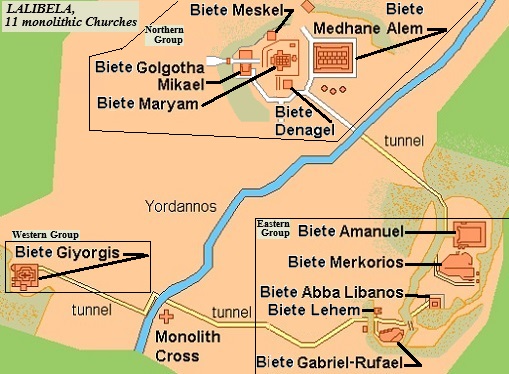 |
|
| |
General
information:
1- river Yordannos =
river Jordan
2- Bet = Bete = Biete = House =
Church
3- Bet Ghel = Bet
Denagel
|
|
| |
|
Thông tin
chung:
Công tŕnh: Nhà thờ tạc vào đá ởLalibela,Ethiopia(Rock-Hewn Churches,
Lalibela,Ethiopia)
Địa
điểm: Lalibela,Ethiopia
Thiết kế kiến trúc:
Quy
mô:Bao gồm 11 nhà thờ Di sản
Năm thực hiện: Thế kỷ 12 –
13
Giá trị: Di sản thế giới (1978; hạng mục i; ii; iii
)
Lalibela là một thị trấn ở miền
bắc Ethiopia, một trong những thành phố linh thiêng nhất
của Ethiopia, chỉ đứng thứ hai sau Aksum(thành phố ở bắc Ethiopia được đặt
tên theo Vương quốc Aksum tồn tại từ năm 400 trước Công nguyên
đến thế kỷ 10, cũng được công nhận là Di sản thế giới năm
1980) và làmột trung tâm hành hươngcủa những người Kito
giáo tại Ethiopia.
Lalibela có số dân khoảng 1,5 vạn người,
nằm tại khu vực có độ cao 2500m so với mực nước
biển.
Thị trấn Lalibela được biết đến trên toàn thế
giới nhờ các nhà thờ bằng đá nguyên khối. Đây là công tŕnh
được xây dựng vào thế kỷ thứ 12 và 13 dưới thời vuaGebre
Mesqel Lalibela, một trong những vị vua cuối cùng của triều
đại Zagwe, người được coi là một vị thánh của Giáo hội chính
thống Ethiopia, với hy vọng nơi đây trở thành một"New
Jerusalem”.
Các nhà thờ không được xây dựng theo cách
truyền thống mà đă được đẽo từ khối đá nguyên khối tự
nhiên. Các khối công tŕnh này tiếp tục được đục ra, tạo
thành cửa ra vào, cửa sổ, cột, sàn khác nhau, mái nhà. Ngoài
công tŕnh, c̣n có hệ thống mương thoát nước, hang động cho
các cư sĩ, hầm mộ cũng được đục từ trong khối đá.
Mặc dù
các khối đá tương đối mềm và dễ đục đẽo, nhưng thiết kế phải
được h́nh tượng từ trước khi công việc bắt đầu. Không có khả
năng sửa đổi hoặc điều chỉnh sau đó. Các công tŕnh thực
chất là một tác phẩm điêu khắc. Việc xây dựng các nhà thờ điêu
khắc rất tiêu tốn thời gian và gặp nhiều khó khăn, song quá
tŕnh này không phải là công việc mà là các trải nghiệm về
tinh thần, biểu hiện hành vi của ḷng sùng kính.
Các nhà
thờ đá tại thị trấn Lalibela chỉ là một trong số 1.500 nhà thờ
điêu khắc đá ở Ethiopia.
11 nhà thờ trong số đó
nằmtại thị trấn
Lalibelađă đượcUNESCOcông nhận
là Di sản thế giớivào năm1978.
Hiện tại một số nhà thờ phải
làm các mái che để bảo vệ khỏibị xói ṃn liên
tục.
|
|
| |
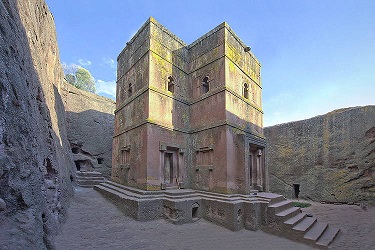 |
| church st Georges, Biete
Giyorgis |
| | |
|
| |
|
|
|
| |
|
|
2 |
Christianity
in Ethiopia - in English, French & Arabic Go
to this Page |
|
|
| |
|
| 1- |
|
Download the bible in Amharic
language |
the bible in Amharic
language -
6.93 MB Pdf file
download |
|
|
|
|
|
|
|
|
|
| |
|
|
3 |
Ethiopian Christian Art -
Crosses, Icons, Paintings, Monasteries ... >>>>
Visit Page, Ethiopian Christian Art - Crosses, Icons ... |
|
|
| |
|
| |
|
|
4 |
LALIBELA, Land
of 11 monolithic Churches |
|
|
| |
In a mountainous region in the heart of
Ethiopia, some 645 km from Addis Ababa, eleven medieval
monolithic churches were carved out of rock. Their building is
attributed to King Lalibela who set out to construct in the
12th century a ‘New Jerusalem’, after Muslim conquests halted
Christian pilgrimages to the holy Land. Lalibela flourished
after the decline of the Aksum Empire, (the capture of
Jerusalem in 1187 by Muslim leader, Saladin).
There are assembled in 3 groups of
churches - 11 churches:
- The Northern Group, the north of the river Jordan
- The Eastern Group, the south of the river Jordan
- The Western Group
|
| |
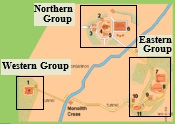 |
|
Lalibela Map |
|
|
|
|
| |
|
| |
|
4.1 |
The Western Group,
Site Plan, Biete Giyorgis |
|
|
| |
|
|
|
4.1.0- the Site plan |
|
Visit Page -
"Biete Giyorgis,
LALIBELA, ETHIOPIA"
|
| The Western Group, 3th
Group, 1 Church |
| |
| |
| |
1- Biete
Giyorgis
. | |
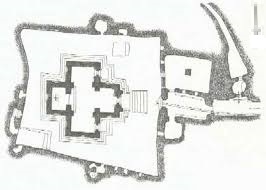 |
|
| |
The Western
Group, 1 Church
- Biete Giyorgis
(Church of Saint George), thought to be the most finely
executed and best preserved church
The
eleventh church, Biete Ghiorgis (House of St. George), is
isolated from the others, but connected by a system of
trenches1
|
|
| |
|
4.1.1- Biete Giyorgis (Church of Saint George) |
|
Visit Page -
"Biete Giyorgis,
LALIBELA, ETHIOPIA " |
North of the
Jordan river, but much further to the west, and somewhat
isolated from the others, is the remarkable church of Bet Giyorgis, possibly the most elegant of all the Lalibela structures,
located in the south-west of the village on a sloping rock terrace.
In a deep pit with perpendicular walls, it can only be reached
through a tunnel entered a distance away through a trench. Small
round caves and chambers have been found in the courtyard walls —
graves for pious pilgrims and monks.This famous church stands alone
in the southwest. Dating to the early 13th century AD, it is the
most recently built of the Lalibela churches.
The most famous of the
churches at Lalibela is "Beta Giyorgis" (The House of
Saint George). It is not part of an interconnected
complex, but stands on its own on a plinth in a
rectangular pit 11 metres deep, with a 30 metre long
approach trench. It has blind lower windows, in an
Aksumite style, with higher open windows central to each
face when viewed from the outside.
Standing on a three-tiered
plinth, Bet Giyorgis is shaped like a Greek cross and has walls —
with an alternation of projecting and recessing horizontal layers —
reminiscent of Axumite archi¬tecture. The church also has an
elaborately shaped doorway.
|
|
| |
|
|
|
|
|
|
| |
|
|
| Area View of Western
Group of Church, Bet Giyorgis |
2.1- The Northern
Group, the north of the river Jordan:
| |
|
|
|
| |
|
|
4.2 |
The Eastern
Group, South of river Jordan & Site Plan: |
|
|
| |
|
| |
|
4.2.0- the Site plan of this
Group |
| |
|
The Eastern Group, 2nd Group, 5
churches |
| |
| |
| |
| |
1- Biete
Amanuel.
2- Biete
Qeddus Mercoreus.
3- Biete
Lehem.
4- Biete Abba
Libanos.
5-
Gallery.
6- Deep pit with
subterranean cistern and well..
7- Biete Gabriel-Rufael.
8- Original
entrance to Biete Gabriel-Rufael
9- Central trench.
10- Great
outer trench.
11- Entrance
path.
12- Approach to " Path to
Heaven".
13-
Road
. | |
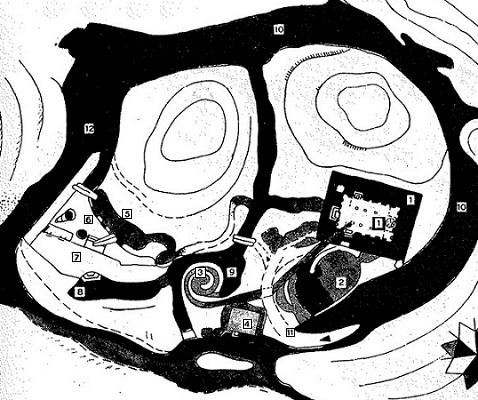 |
|
| |
|
The Eastern Group, 5 Churches |
- Biete Amanuel (House
of Emmanuel), possibly the former royal chapel, 9
rooms in the 3 stories church
- Biete Qeddus
Mercoreus (House of St. Mercoreos/House of St. Mark), which
may be a former prison
- Biete Abba Libanos
(House of Abbot Libanos),
(that King Lalibela's wife carved
this church
- Biete Gabriel-Rufael
(House of the angels Gabriel, and Raphael) possibly a former
royal palace, linked to a holy bakery.
- Biete Lehem (House
of Holy Bread).
|
| |
|
|
| |
| |
|
4.2.1- Biete Amanuel,
(House of Emmanuel) |
|
Visit Page -
"Biete Amanuel,
LALIBELA, ETHIOPIA" |
- The Biete Amanuel (House of
Emmanuel), possibly the former royal chapel, 9 rooms
in the 3 stories church
- It is the most beautifully carved church with a typical ancient Axumite architectural style i.e. projecting and recessing walls.
- There are two rows of windows in the façade, of which the lower ones are cross-shaped and the upper ones square heads.
- It is a three-story building in which the ground class is cross-shaped.
- It has richly ornamented external walls by
horizontal carvings
|
|
| |
|
|
|
|
|
|
| |
|
|
2.1- The Northern
Group, the north of the river Jordan:
|
|
| |
|
|
| |
|
|
| |
|
|
| |
| |
|
4.2.4- Biete Gabriel-Rufael
(House of the angels Gabriel, and Raphael) |
|
Visit Page -
"Biete Gabriel-Rufae,
LALIBELA, ETHIOPIA" |
-
The Biete Gabriel-Rufael
(House of the angels Gabriel, and Raphael) possibly a former
royal palace, linked to a holy bakery.
It has an impressive monumental façade facing to the north and ornamented with original niches whose top shape is similar to the top part of the Axumit Stele.
-
Near to the church, there is a carved band of rock locally called ‘the path of heaven’. It is a wall shaped and rises from the ground and ascending to the roof.
-
There is a well and underground cistern down in the courtyared.
-
It is a church whose original entrance is still hidden. Access to the church is through long bridge crossing the main trench.
-
There are three straight Latin crosses incised in to the interior wall.
-
There is also a huge manuscript called ‘Gedle Sema’etat” (Hagiograph of Martyrs).
-
It has not east-west orientation, thus some speculates it was originally built for secular purposes rather than the church.
|
|
|
|
|
|
|
|
| |
| |
|
|
.jpg) |
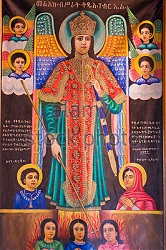 |
.jpg) |
|
Entrance |
the Archangel Michael Icon |
Priest Stands |
|
|
| |
|
| |
| |
|
4.2.5- Biete Lehem
(House of Holy Bread). |
|
Visit Page -
"Biete Lehem,
LALIBELA, ETHIOPIA" |
| The Biete Lehem is an underground
monolith church carved into rock. It is located in
Lalibela, Ethiopia. It was created during the Kingdom of
Axum. It is part of UNESCO World Heritage Site at Lalibela.
The name Biete Lehem is from Biete lehem Hebrew (House of
Holy Bread) |
|
| |
|
|
|
|
|
|
|
|
| |
|
|
|
|
|
| |
|
|
4.3 |
The
Northern Group, north of river Jordan & Site Plan: |
|
|
| |
|
| |
|
4.3.0- the Site plan of this Group |
| |
|
The
Northern Group,
1st Group, 5 Churches |
| |
| |
| |
| |
1- Trench.
2-
Tomb of
Adamo.
3- Biete Golgotha
Mikael.
4-
Crypts.
5- Passage to tomb
block
. 6-
Ancient subterranean
passages.
7- Entrance to
courtyard of Biete
Maryam
8-
Biete Meskel
9- Biete
Denagel (Ghel or
Virgins)
10- small
pool.
11-
Courtyard of Biete
Maryam.
12- Biete
Maryam.
13-
Courtyard of B.
Medhane Alem & trenches.
14-
Biete Medhane
Alem
. | |
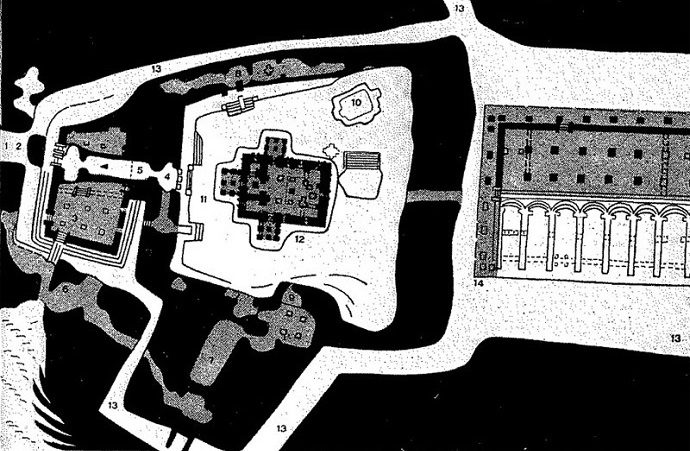 |
|
| |
| |
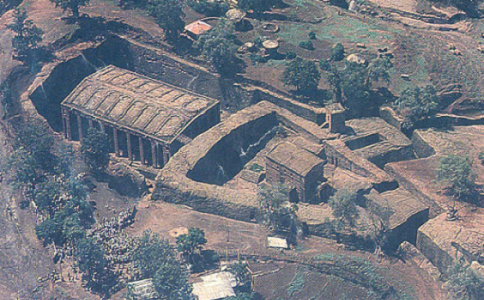 |
|
Area View of
Northern (First) Group of Churches |
|
| |
|
The Northern Group, 5 Churches |
- Biete Medhane Alem
(House of the Saviour of the World), home to the Lalibela
Cross, believed to be the largest monolithic church in the
world..
- Biete Maryam (House
of Miriam/House of Mary), possibly the oldest of the
churches, and a replica of the Tombs of Adam and
Christ.
- Biete Golgotha
Mikael (House of Golgotha Mikael), known for its arts and
said to contain the tomb of King Lalibela)
- Biete Meskel (House
of the Cross)
- Biete Denagel (House
of Virgins)
|
| |
|
|
| |
| |
|
4.3.1- Biete Medhane
Alem (House of the Saviour of the World) |
|
Visit Page -
"Biete Medhane Alem,
LALIBELA, ETHIOPIA" |
|
This church is in the northern part of the complex, and
perhaps the oldest of the Lalibela churches. Bet Medhane Alem is the largest of
all the Lalibela churches. Built like a Greek temple, it is unusual,
being entirely sur¬rounded by square columns, with a further forest
of twenty-eight massive rectangular columns supporting the roof
inside. Polished by centuries of pressure from countless feet, the
stone floor reflects shafts of light from apertures in the walls
high above. In a corner, one can see three empty graves said to have
been symbolically dug for biblical patriarchs Abraham, Isaac, and
Jacob.
|
|
| |
|
|
|
|
Plan of Page, "Biete
Medhane Alem, LALIBELA, ETHIOPIA":
-
Biete Medhane Alem Description, (Plans,3D Models, Video, 3D Panorams Views)
-
Outside of Biete Medhane Alem, (Gallery of Photos ..).
-
Iutside of Biete Medhane Alem, (Gallery of Photos ..).
- The Tunnel between the Northern Group of 5 Churches
|
|
|
| |
|
|
2.1- The Northern
Group, the north of the river Jordan:
|
|
| |
|
|
| |
| |
|
4.3.2- Biete Maryam (House of Miriam/House of Mary) |
|
Visit Page -
"Biete Maryam,
LALIBELA, ETHIOPIA" |
- This rectangular church is
the most ornate of the Lalibela churches and
is surrounded by a trapezoidal courtyard.
- Debre-Sina (House of Mount Sinai)
It has also a covered pillar like Biete Mariam
There are many carefully carved pillars in the interior, which are cruciform in croos-section, with double capitals and decorated by varieties of crosses.
|
|
|
|
|
|
|
|
| |
| |
|
|
|
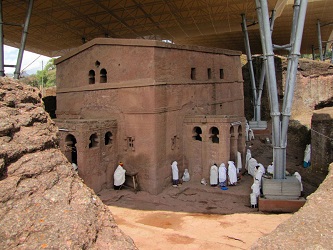 |
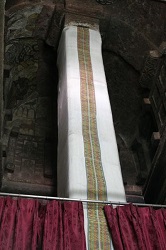 |
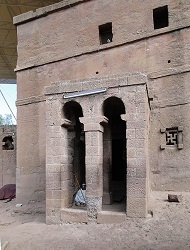 |
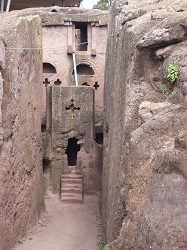 |
| Biete
Maryam |
Picture of Pillar |
The Entrance |
Tomb of Adamo |
|
2.1- The Northern
Group, the north of the river Jordan:
|
|
| |
|
|
| |
| |
|
4.3.3- Biete Golgotha Mikael (House of Golgotha Mikael) |
|
Visit Page -
"Biete Golgotha Mikael ,
LALIBELA, ETHIOPIA" |
-
The interconnected churches
of Biete Golgotha and Biete Mika'el
form the most mysterious complex in Lalibela. Its holiest shrine —
the Selassie Chapel — is housed here, and, according to the whispers
of the priests, perhaps even the tomb of King Lalibela himself. Some
of the most beautiful processional crosses of Lalibela are here.
One, a very rich and elaborate metal cross, black with age and
decorated with inlaid circles, is said to have belonged to Lalibela.
It contains larger than life bold-relief figures identified as Saint
John, Saint Stephen, Saint George and Saint Kirkos, as well as the
purported tomb of King Lalibela.
- Biete-Debre Sina and Biete-Golgotha
These are twin churches separated by a wall, east
of which is Gologtha and to the west is Debre Sina.
The local people called them together “Biete Qidus Michael’ (House of St. Michael).
|
|
|
|
|
|
|
|
|
|
| |
|
|
|
| |
| |
|
4.3.4- Biete Meskel (House of the Cross) |
|
Visit Page -
"Biete Meskel,
LALIBELA, ETHIOPIA" |
- Biete
Meskel underground
monolith church carved into rock. It is located in Lalibela, Ethiopia.
The edifice was built during the Kingdom of Axum
- This is a grotto
church, partially carved out of the rock, and whose
façade is level with the north wall of the courtyard of
Biete Maryam
- This
Carved in to the northern wall of Biete Mariam and has only one façade, facing south and decorated by ten blind arcades.
- According to priests of Lalibela, the ten blind arcades represent the Ten Commandments and the ten churches of Lalibel (the twin churches are considered as one).
- Internally it is decorated with many relief crosses and houses the most ornamented cruciform chamber, which is accessible to visitors.
|
|
|
|
|
|
|
|
|
|
| |
|
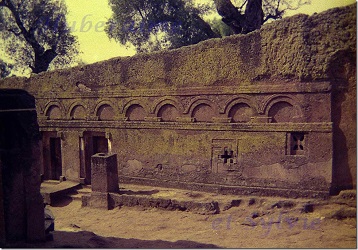 |
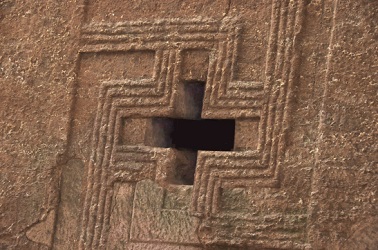 |
|
Ten
arches symbolize the ten commandments, the
smallest church |
|
|
| |
|
|
| |
|
|
| |
|
|
|
|
|
|
|
|
|
|
|
|
|
| www.puresoftwarecode.com
: |
|
HUMANITIES
Institute |
ART Institute
& Others |
| SOFTWARE
Institute |
CHRISTIANITY
Institute |
|
|
|
"Free, 100 Software
Programming Training Courses"
|
|
Le
HANDICAP c'est quoi ? (in French) |
Basilica
Architecture, in the Shape of a Cross |
| VISUAL STUDIO 2010 in
English |
Holy BIBLE in 22 Languages and Studies
... |
Drugs and Treatment in English, french,
Arabic |
Old Traditional Lebanese
houses |
| VISUAL STUDIO .NET, Windows & ASP in
English |
220 Holy Christian
ICONS |
Classification of Wastes from the Source
in Arabic |
5 DRAWING Courses & 3 Galleries |
| VISUAL STUDIO 6.0 in
English |
Catholic Syrian MARONITE Church
|
|
Meteora,
Christianity Monasteries - En, Ar, Fr |
| Microsoft ACCESS in
English |
HOLY MASS of Maronite Church - Audio
in Arabic |
Christianity in the Arabian Peninsula in
Arabic |
Monasteries of Mount Athos & Pilgrimage |
| PHP & MySQL in
English |
VIRGIN MARY, Mother of JESUS CHRIST
GOD |
Summary of the Lebanese history in
Arabic |
Carved
Rock Churches, in Lalibela, Ethiopia |
| SOFTWARE GAMES in
English |
SAINTS of the Church |
LEBANON EVENTS 1840 & 1860, in
Arabic |
|
| WEB DESIGN in English |
Saint SHARBEL - Sharbelogy in 10
languages, Books |
Great FAMINE in LEBANON 1916, in
Arabic |
my PRODUCTS, and Statistiques ... |
| JAVA SCRIPT in
English |
Catholic RADIO in Arabic, Sawt el
Rab |
Great FAMINE and Germny Role 1916,
in Arabic |
|
| FLASH - ANIMATION in
English |
Читать -
БИБЛИЯ и Шарбэль cвятой, in Russe |
Armenian Genocide 1915 in
Arabic |
4 Different
STUDIES |
| PLAY, 5 GAMES |
|
Sayfo or Assyrian Genocide 1915 in
Arabic |
SOLAR Energy & Gas
Studies |
| |
|
Christianity in Turkey in
Arabic |
WELCOME to LEBANON |
| SAADEH BEJJANE
Architecture |
|
|
YAHCHOUCH, my Lebanese
Village |
| |
|
Prononce English and French and Arabic
Letters |
ZOUEIN, my Family - History &
Trees | |
|
|
|
|
| | | | |